
Cactus on the back porch on 9-22-21, #833-2.
Hello everyone! I hope this post finds you well. I am doing fine for the most part… I am just less motivated this time of the year but there are things I need to get done.
Before I begin with this post, let me just say I don’t think I have a green thumb. I like a wide variety of plants that have different but similar requirements. Hmmm… I just confused myself. For the most part, the potted plants on the front porch need a shadier area, and the plants on the back porch prefer full sun. This year a few plants were under the roof on the back porch so they wouldn’t be in full sun and only received morning sun. Some of the plants on the front porch would probably like the back porch better. Maybe next year… We have to get through the winter first. 🙂
Linda, from The Task at Hand, commented on the last post concerning cactus getting wet in direct sunlight. I mentioned in the post what LLIFLE (Encyclopedia of Living Forms) said, but I will quote here what the website says about the cultivation and propagation on the Ferocactus wislizeni page: “Use very draining soil, water during the aestival growth cycle (this plant need plenty of water) But needs to be avoided wetting the bodies of these plants while they are in sunlight. A wet cactus in the sunlight can cause sun burning which can lead to scars or even fungal infections and death. Needs full sun. Keep dry at 10”… Normally, much more is written about cultivation and propagation so I think he didn’t get finished or something went wrong which is why the information stops “at 10”. 10 what? LLIFLE is a very reliable source of information but experience is always the best teacher.
Many cactus have specific requirements in nature which is why they grow in certain areas. I am sure in nature cactus get wet followed by sun which possibly leads to scarring, infection, and death for some species. Other species may not be affected by getting wet in full sun. Personally, I don’t water any of my plants when the sun is on them or if the night temperatures will be cool (especially for cactus and succulents). This can be tricky when it comes time to bring the plants inside for the winter. Last year it was fairly dry when I brought the plants inside, but it was the opposite this year. We had cool temps and it rained. I wasn’t worried about the plants on the front porch because they were under a roof. The cactus on the back porch were in the elements getting wet when temps were around 40° F… Many cactus have no issues with temps even below freezing when they are in the ground in their native habitat because they go dormant. Some species go dormant in the heat of the summer. Some grow way up in the mountains… But, my cactus are in pots and their ancestors grow in many different areas from forests to deserts from high to low elevations. It is a lot different in pots in west-central Missouri than in their native habitat…
Jim, from How I See It, in his comment asked a very good question… “Are plants like these abundant from their places of origin? Do you ever encounter plants that should not be traded on the plant market because they are endangered, etc?’ My reply was that I normally check the IUCN Red List about their status in nature. Many of the species in my collection are not endangered but some are for a variety of reasons. While some species have been collected to near extinction in the past, those species are illegal to collect in the wild now. Some species become endangered due to growing agricultural needs and their environment changes. Many species have been collected and relocated to save them. The plants in my collection come from commercial growers and are likely grown from seed. Even so, it bothers me when I have a species that are endangered in the wild due to overcollection. Upon further research, I found out the UNEP World Conservation Monitoring Centre says trade is controlled to avoid use incompatible with species survival with every species of cactus in my collection…
There are many species that shouldn’t be available on the market for several reasons. One is because they have requirements the average person can’t fill and eventually die. I have noticed in the last few years commercial growers sell seed-grown plants to Wal-Mart, Lowe’s, etc. that are very small that really struggle to survive. Most of the very small plants I have bought in the past few years, like in 2” pots, from Wal-Mart and from Ebay have died.
If you missed the previous post, Fall 2021 Cactus Update Part 1, is about the cactus on the back porch up to the Mammillaria. You can click on the plant’s name to go to their own pages for more information about the species and see all their photos.
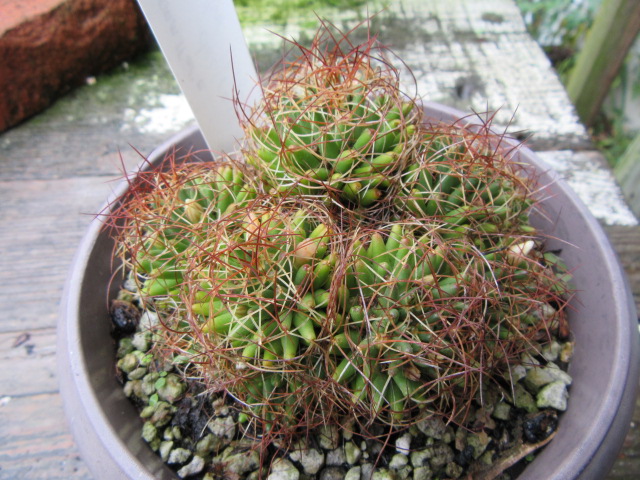
Mammillaria decipiens (syn. subsp. camptotricha) (Bird’s Nest Pincushion) at 2″ tall x 4 1/2″ wide on 10-28-21, #853-12.
The Mammillaria decipiens (subsp. camptotricha) (Bird’s Nest Pincushion) did GREAT over the summer. The tallest plant in the cluster measured 2″ tall and the group expanded to 4 1/2″ wide. To think it was only 1 1/2″tall x 3″ wide when I brought it home from Wal-Mart on March 19 in 2018… It is really hard to tell, but I believe we have a few new offsets. There were five plants in the cluster when I brought it home and I think there are 12 now. I really like this species… This species has 19 synonyms and has been in 8 genera. Ummm… The subspecies name is a synonym…
The IUCN Red Lists says this species is stable in its natural habitat. Mammillaria decipiens are native to San Luis Potosi, Guanajuato, and Queretaro in Mexico where they grow at an altitude between around 5,085 to almost 8,000 feet above sea level (1550-2150 meters).
<<<<+>>>>
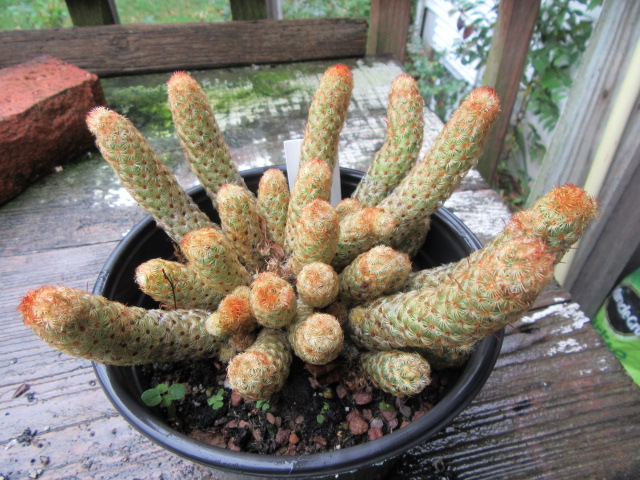
Mammillaria elongata (Ladyfinger Cactus) on 10-28-21, #853-13.
The Mammillaria elongata (Ladyfinger Cactus) continues to go bananas. The longest stem in the center of the pot broke in half over the winter then died. Now the longer stems measure from 3 to 3 3/4″ long. I counted 39 stems and offsets and some are very tiny. There are even offsets growing along some of the taller stems. Hmmm… I should have taken a photo from a different angle but I was in a hurry. There was one stem with 11 offsets when I brought this plant home from Wal-Mart in 2018.
The IUCN Red List indicates this species in declining in its native habitat due to agriculture, aquaculture, industry, and mining.
LLIFLE (Encyclopedia of Living Forms) says this may be the most common Mammillaria to be found. It occurs in more variations than any other Mammillaria species. It commonly comes in many color and spine variations. Plants of the World Online by Kew lists 52 synonyms and has been in six genera.
<<<<+>>>>
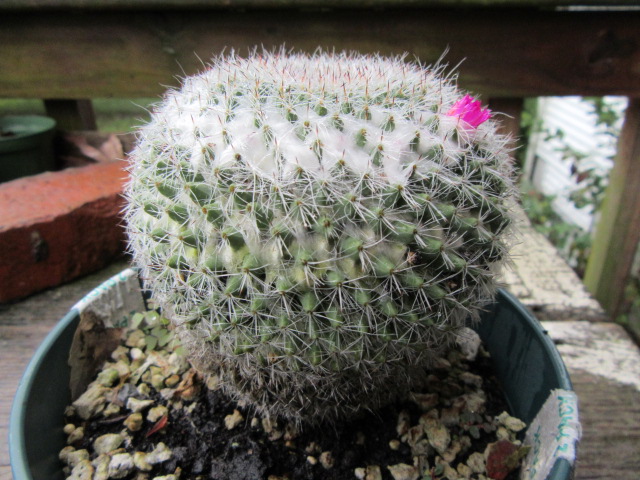
Mammillaria hahniana (Old Lady Cactus) at 3 3/4″ tall x 3 3/4″ wide on 10-28-21, #853-14.
As always, the Mammillaria hahniana did very well over the summer and grew to about 3 3/4″ tall x 3 3/4″ wide. It looks a little strange because it had rained so its wool was wet. This plant was only 1 7/8″ tall x 2 3/8″ wide when I brought it home from Wal-Mart on February 1 in 2016. I have really enjoyed this plant.
The two unlabeled cactus I brought home from Wal-Mart last December 2, that turned out to be different looking Mammillaria hahniana, died over the summer. In fact, all four cactus I brought home that day died… They were all very small…
The IUCN Red List says Mammillaria hahniana is of least concern in its native habitat.
<<<<+>>>>
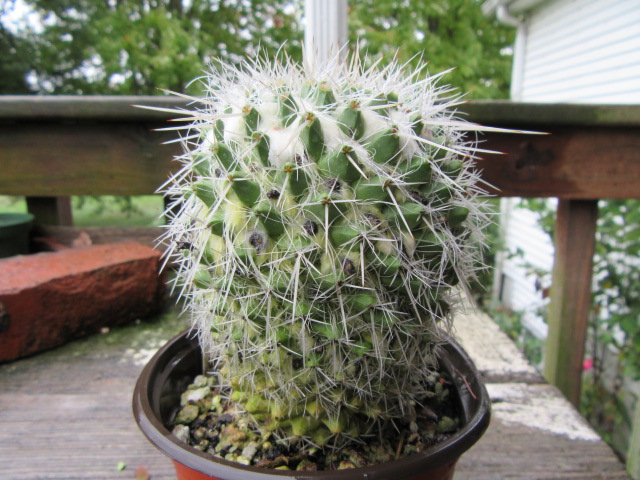
Mammillaria karwinskiana (syn. subsp. nejapensis) (Silver Arrows) at 4″ tall x 35/8″ wide on 10-28-21, #853-15.
The Mammillaria karwinskiana (syn. subsp. nejapensis) (Silver Arrows) did really well over the summer and grew to 4″ tall x 3 5/8″ wide. It didn’t especially like being photographed with wet wool since it had been sprinkling. I explained it was very important and I would take another photo of it when it starts blooming. It normally starts flowering up a storm shortly after I bring the plants inside. This plant has grown quite a bit from 1 7/8″ tall x 2 3/16 when I brought it home from Lowe’s on September 21 in 2018.
It is one of a few Mammillaria species in my collection that are dichotomous branching. That means it will split to form two plants.
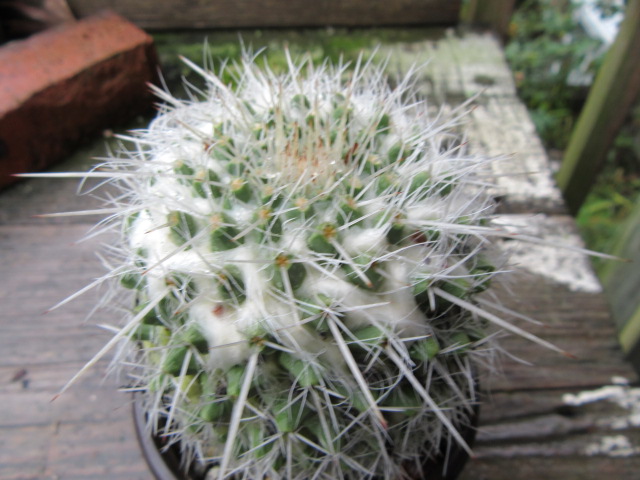
Mammillaria karwinskiana (syn. subsp. nejapensis) (Silver Arrows) from the top on 10-28-21, #853-16.
I really like this plant and the way its wool weaves through its tubercles.
The IUCN Red List says this species is stable in its native habitat in Central and Southwest Mexico and Guatemala.
<<<<+>>>>
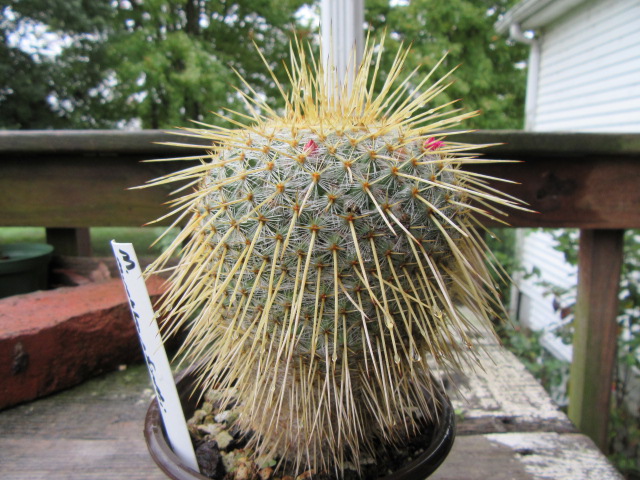
Mammillaria muehlenpfordtii (Golden Pincushion) at 4 3/4″ tall x 3 1/4″ wide on 10-28-21, #853-17.
The Mammillaria muehlenpfordtii (Golden Pincushion) did very well over the summer and grew to 4 3/4″ tall x 3 1/4″ wide. It was 3 3/4″ tall x 2 1/8″ wide when I brought it home from Lowe’s on September 21 in 2019. This one is also dichotomous branching. I really like this cactus with its blue-green color and long golden spines. Its shape reminds me of a light bulb…
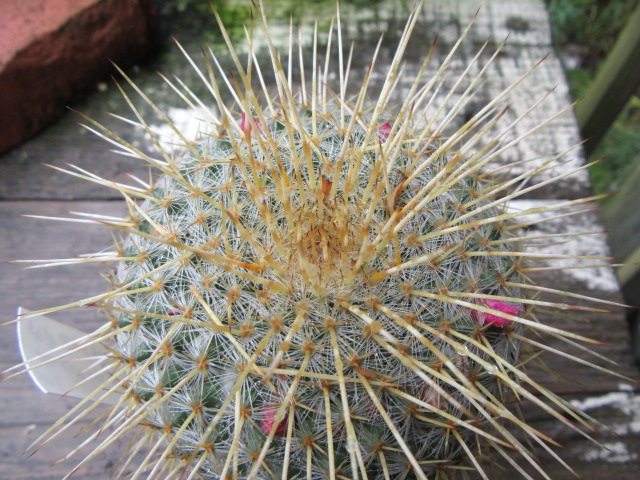
Mammillaria muehlenpfordtii (Golden Pincushion) from the top on 10-28-21, #853-18.
It has a few more buds to become flowers I will miss AGAIN. This plant was LOADED with buds that were ready to open on June 24. I checked every day to get a photo of its flowers and the next thing I knew the buds had turned to faded flowers. It has had buds multiple times but I have never seen them open…
The IUCN Red List says this species is stable in its native habitat in Guanajuato, Querétaro, and San Luis Potosí in Mexico. It lists no threats.
<<<<+>>>>
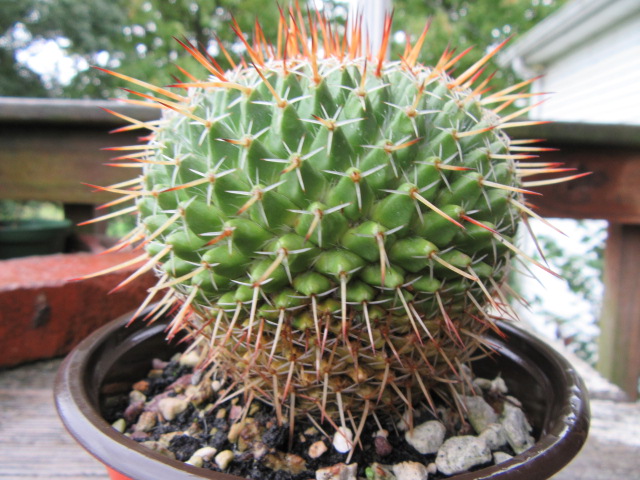
Mammillaria mystax at 3 1/8″ tall x 3 1/4″ wide on 10-28-21, #853-19.
The Mammillaria mystax is a very well-behaved cactus that has no issues. It grew to 3 1/8″ tall x 3 1/4″ wide over the summer and was 1 3/4″ tall x 2 1/4″ when I brought it home from Lowes on September 21 in 2018. It has very sharp reddish-brown tipped spines.
The Mammillaria mystax is a pretty straightforward plant with very prominent 4-6 angled tubercles. In the wild, it produces very long, entangled spines on its crown but that seldom happens in cultivation. This species divides dichotomously as well as possibly producing offsets. It will produce a ring of rose flowers with brown mid-veins in up to 3 rows which hasn’t happened yet…
The IUCN Red List says this species population is stable in its native habitat in South Central Mexico.
<<<<+>>>>
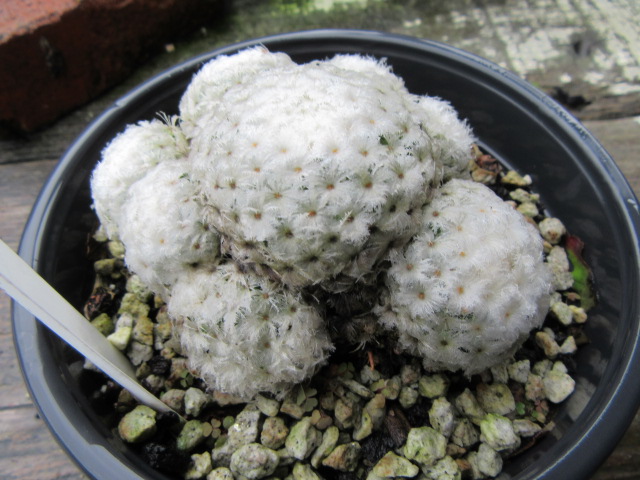
Mammillaria plumosa (Feather Cactus) at 1 3/4″ tall x 4 3/8″ wide on 10-28-21, #853-20.
The Mammillaria plumosa (Feather Cactus) may look a little strange in the above photo because its “plumage” was kind of wet from the rain. It did very well over the summer and the largest plant in the cluster grew to 1 3/4″ tall. The entire cluster measured 4 3/8″ wide. It was 3/4″ tall x 2 1/4″ wide when I received it from a seller on Ebay on September 22 in 2019. I still have to smile when I look at the photo when it arrived all wrapped up in toilet paper. I must say, it has done great and was one of my better buys on Ebay. You would be amazed at how many cactus and succulents are listed.
The IUCN Red List states the population is declining and near threatened in its native habitat in Coahuila and Nuevo León in Mexico where it grows on limestone cliffs in sparse xerophytic shrubland. This species is illegally collected for the ornamental trade. The local community in the area also collects plants from the wild and sells them at local markets at Christmas time, as they are used to decorate nativity scenes.
<<<<+>>>>
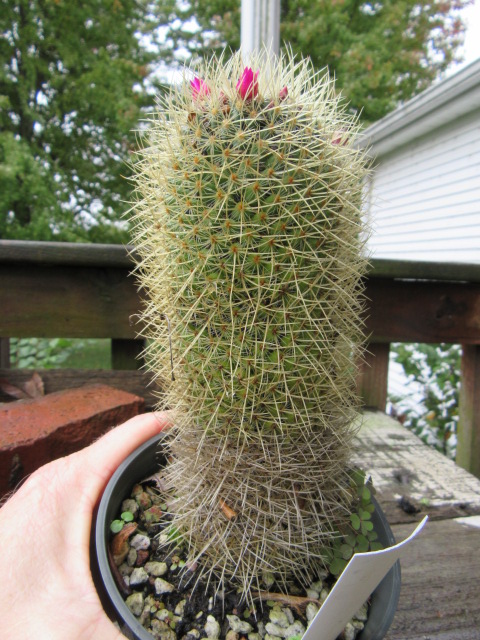
Mammillaria pringlei (Lemon Ball Cactus) at 6 1/2′ tall x 2 5/8″ wide on 10-28-21, #853-21.
The Mammillaria pringlei Lemon Ball Cactus) did very well again over the summer and grew to 6 1/2″ tall x 2 5/8″ wide. It has leaned over the summer AGAIN so I need to re-pot it and straighten it up. Many species of cactus are leaners and this one does it more than any other in my collection… This time the pot won’t stand up on its own. GEEZ! The Mammillaria pringlei is one of the most abundant bloomers I have. It produces a lot of flowers in multiple rows.
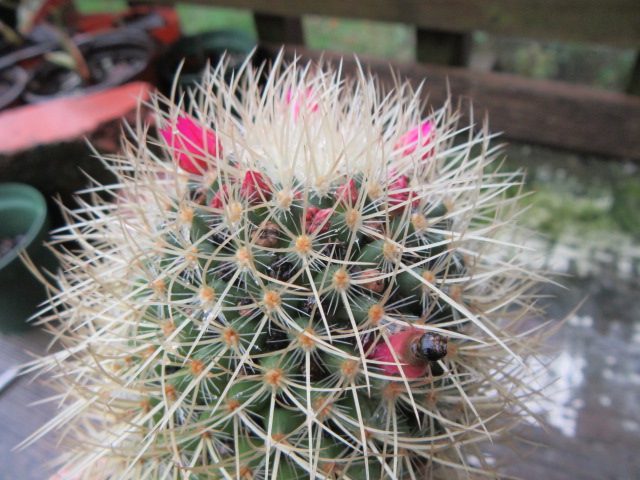
Mammillaria pringlei (Lemon Ball Cactus) on 10-28-21, #853-22.
Blooming again and it appears there is a fruit… Hmmm… A while back I received a comment from a reader who said she had purchased a Mammillaria karwinskiana in the spring and in the last month was producing magenta seed pods. She hadn’t seen any flowers and was wondering could there really be that much of a delay. Well, of course, I sent her a lengthy reply. 🙂 I told her I rarely see any fruit on my cactus, which is true because they need two plants of the same species to pollinate. Usually, I only see fruit on my cactus within a few months after I bring them home if they have been pollinated where they were grown. Mammillaria pringlei, on the other hand, has produced fruit several times and I don’t quite understand why… It could possibly be pollinated from the M. rhodantha since was formerly M. rhodantha subsp. pringlei… It is still considered a part of the Mammillaria rhodantha complex…
The IUCN Red List of Threatened Species lists Mammillaria pringlei as vulnerable in its natural habitat. This is due to its restricted range, being present in only three areas. Llifle (Encyclopedia of Living Forms) states it has experienced declines due to the collection of its flowers and even whole plants for Christmas decorations. Apparently, at one point this species was not found in any of the protected areas.
<<<<+>>>>
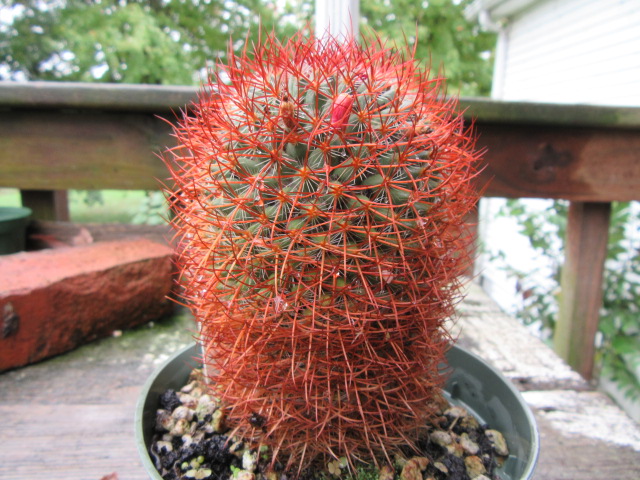
Mammillaria rhodantha (Rainbow Pincushion) at 4 1/8″ tall x 2 3/4″ wide on 10-28-21, #853-23.
Who wouldn’t like the Mammillaria rhodantha (Rainbow Pincushion)? Those reddish spines would get anyone’s attention. This plant has always done well and grew to 4 1/8″ tall x 2 3/4″ wide over the summer. It has been a slower grower compared to the Mammillaria pringlei. It was 3 3/4″ tall when I brought it home from Wal-Mart on February 1 in 2016. That measurement likely includes the spines…
“This one” blooms kind of strange… Sometimes it has an abundance of buds but only a few of the flowers will open. Then there will be holes where the old buds were.
Mammillaria rhodantha is a VERY variable species which has led to it having a whopping 132 synonyms. Thirty-five of the synonyms are forms, subspecies, or varieties of M. rhodantha…
Mammillaria pringlei and M. rhodantha are also both species that divide dichotomously and also produce offsets.
The IUCN Red List says this species is stable and of least concern in its native habitat. It is a native of high-table lands in Queretaro, Michoacán, Zacatecas, Jalisco, and Hidalgo in Mexico where it grows in fertile soil.
<<<<+>>>>
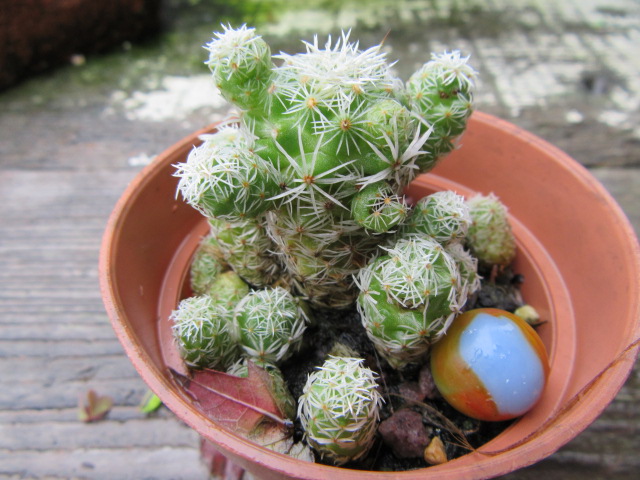
Mammillaria vetula (syn. subsp. gracilis) (Thimble Cactus) at 1 7/8″ tall on 10-28-21, #853-25.
This Mammillaria vetula (syn. subsp. gracilis) (Thimble Cactus) amuses me. I had one before in a good-sized pot that I gave up in 2014. When I went to Lowe’s to find a new one in 2018, I brought home the ‘Arizona Snowcap’. A few days later, I found this very small plant at Wagler’s Greenhouse with a few offsets along its stem. I didn’t realize it was a Mammillaria vetula subsp. gracilis at the time because it wasn’t growing like the one I had previously and it only had one stem… When you find them at a garden center they are usually in a cluster.
The original stem grew a little taller over the summer and was 1 7/8″ tall when the above photo was taken. The offsets that grew on the main stem are still attached from last year. Before that, most of them fell off. I should take a photo from the top so you can see how many offsets there are in this little pot. It needs repotting anyway because I noticed the pot is broken… I have had those pots since 2009 so they are bound to be a little brittle. The plant was in too large of a pot when I brought it home so I put it n a smaller one. It kept leaning over so I put the marble next to it to hold it up. Now it thinks the marble belongs to him (or her).
Even though Mammillaria vetula is the accepted name of the species, it is most often labeled Mammillaria gracilis fragilis at garden centers. It has 24 synonyms including Mammillaria gracilis, M. fragilis, M. gracilis var. fragilis, M. vetula subsp. gracilis, and so on.
What sets this “subspecies” apart from the species is that it usually has no central spines where M. vetula has 1 or two. The species has at least 25 radial spines (up to 50 on mature specimens) where the subspecies only has 11-16. Mine has no central spines…
The IUCN Red List says the species is stable and of least concern in its natural habitat in Hidalgo, Guanajuato, and Querétaro in Mexico where they are found in pine forests at high altitudes.
<<<<+>>>>
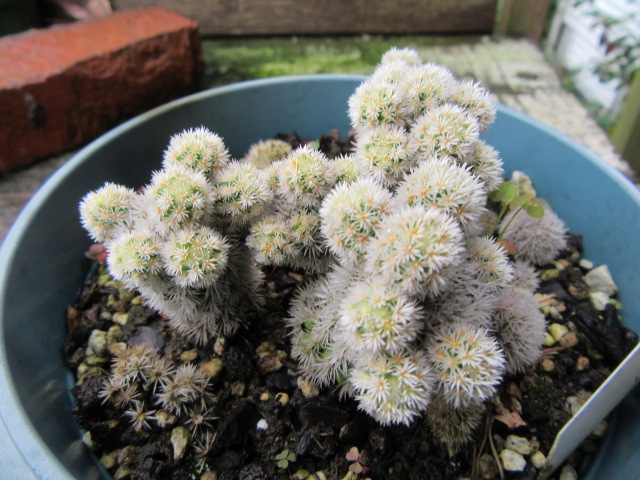
Mammillaria vetula (syn. subsp. gracilis) ‘Arizona Snowcap’ at 2 1/4″ tall on 10-28-21, #853-24.
The Mammillaria vetula (syn. subsp. gracilis) ‘Arizona Snowcap’ (Thimble Cactus) did well over the summer of 2021 and the largest plant in the cluster grew to 2 1/4″ tall… I brought this cactus home from Lowe’s on July 8 in 2018 when the cluster measured 2″ tall x 5″ wide. The pot was bulging and the spines seemed much thicker and more white than the “regular” Mammillaria vetula subsp. gracilis. The pot was labeled Mammillaria gracilis fragilis monstrose so I did some research. As it turns out, this plant was a monstrous form of Mammillaria vetula subsp. gracilis, likely a nursery-produced cultivar and possibly a hybrid, named ‘Arizona Snowcap’. Over the winter I took a couple of photos and a few of the offsets in the pot were nearly solid white and looked like little snowballs. Those plants died… In fact, half of the offsets died. I re-potted what was left and the rest have done pretty well.
<<<<+>>>>
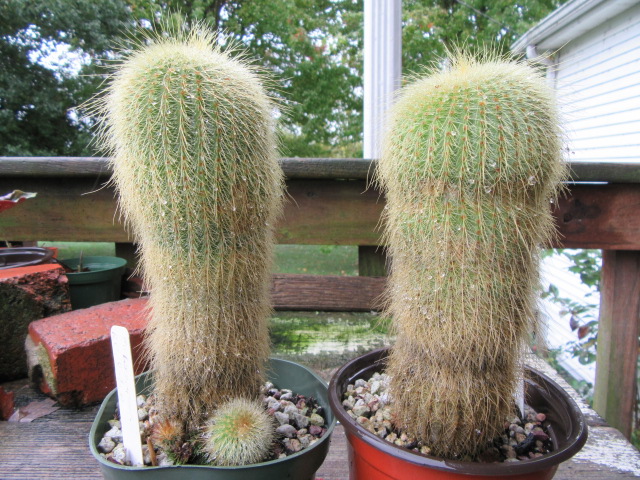
Parodia lenninghausii (Golden Ball Cactus), Lessor (left) at 6 1/2″ tall x 2 3/8″ wide, Greater (right) at 6 1/2″ tall x 2 3/8″ wide on 10-28-21, #853-26.
The two Parodia lenninghausii (Golden Ball Cactus, ETC.) made it through the summer quite well. Lessor, on the left in the above photo grew to 6 1/2″ tall x 2 3/8″ wide. Greater, on the right, grew to 6 1/8″ tall and is the same width as last year at 2 3/8″ wide. Last year they had the same measurements… These two characters have grown quite a lit since I brought them home from Wal-Mart on February 1 in 2016. It was an accident that I brought two home, like usual when I bring two of the same species home, but I am glad I did. Watching these two side by side has been entertaining. Lessor was only 1 7/8″ tall x 1 3/4″ wide when I brought it home and somehow I didn’t measure Greater, which was taller. Last October they were the same size at 6″ tall x 2 3/8′ wide.
They are supposed to produce bright yellow flowers but I read they may need to be 10 years old… Five more years to go. GEEZ!
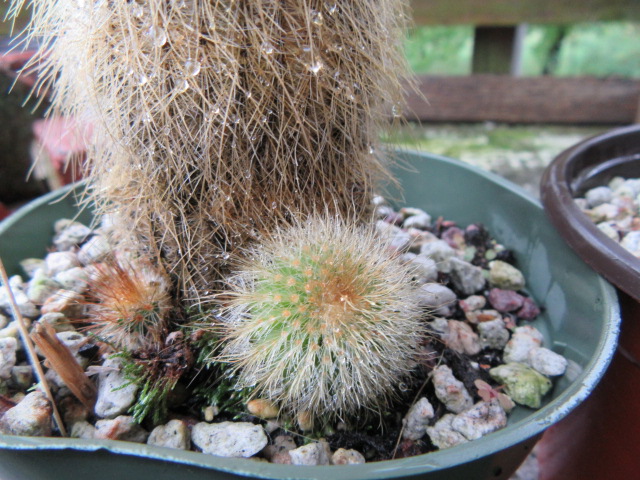
Parodia lenninghausii the Lessor’s offsets on 10-28-21, #853-27.
One of Lessor’s kids grew quite a bit over the summer…
The IUCN Red List doesn’t say anything about this species, but LLIFLE says they are abundant in their native habitat in Rio Grande do Sul in Brazil but many subpopulations have been extirpated… The species grows at elevations between about 985 to 4,265 feet (300-1300 meters) in hilly grasslands and in the shade of larger plants where they tolerate a wide range of temperatures.
<<<<+>>>>
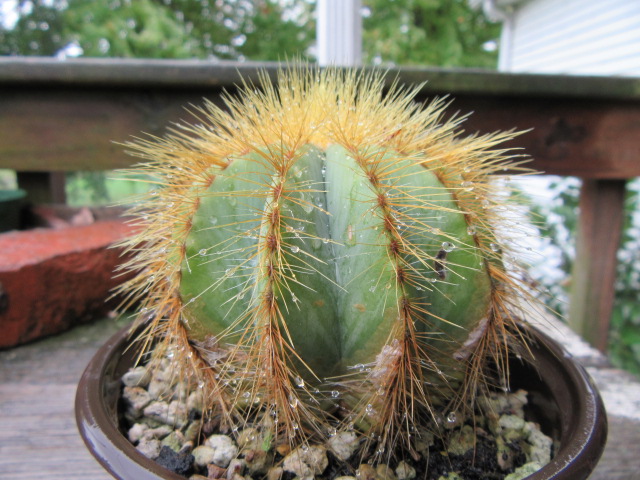
Parodia magnifica at 2 1/2″ tall x 3 1/4″ wide on 10-28-21, #853-28.
The Parodia magnifica (Ball or Balloon Cactus) is a neat species that reminds me of the crown for Imperial Margarine. I did very well over the summer and still measured 2 1/2″ tall but it grew to 3 1/4″ wide. It was 1 3/8″ tall x 2 3/8″ wide when I brought it home from Lowe’s on March 29 in 2019.
Parodia magnifica is a native to Rio Grande do Sul in southern Brazil and are also found nearby in Paraguay, Uruguay, and Argentina. The IUCN Red List has them listed as an endangered species. They grow on hilly grasslands and on walls between cracks in rocks or in the shade of larger growing plants in deciduous forests. In this climate, they experience warm and cool seasons and grow in soil with plenty of organic matter from the decomposition of other plants. It is said Parodia magnifica can survive temps as low as 20° F if their soil is dry and they are not subject to frost.
<<<<+>>>>
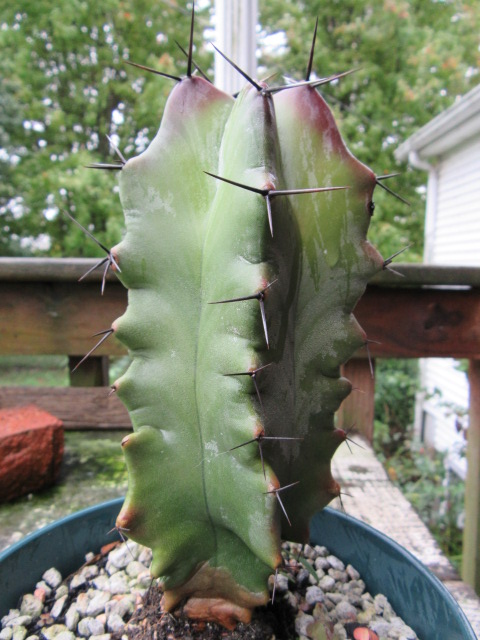
Stenocereus pruinosus (Gray Ghost) at 6 3/8″ tall x 3 1/8″ wide on 10-28-21, #853-29.
I think the Stenocereus pruinosus (Gray Ghost or Organ Pipe Cactus) is a magnificent plant. It always does great over the summer and grew to 6 3/8″ tall x 3 1/8″ wide. It was 2 7/8″ tall x 2 3/4″ wide when I brought it home from Wal-Mart on February 1 in 2016. It stayed 2 3/4″ wide until this year (except it was 3″ wide in 2019). It has been a great all-around plant. The label said they grow to 20′ in time, but reliable sources say 13-16’…
The IUCN Red List says the population of Stenocereus pruinosus is stable and of least concern in its native habitat in Chiapas, Guerrero, Oaxaca, Puebla, and Veracruz in Mexico. They grow at 2,600 to 6,200 feet (800 to 1,900 meters) above sea level where they can be found in tropical deciduous forests. They are known for their edible fruit.
Well, that is it for the cactus that were on the back porch and their pages have been updated…
I will go back to updating the pages to the right. It is sometimes hard to decide what to write about over the winter but I may do a wildflower series. Not that they are blooming now… 🙂 If you have any suggestions, I would like to hear them.
Until next time, take care, stay positive, and always be thankful!

























